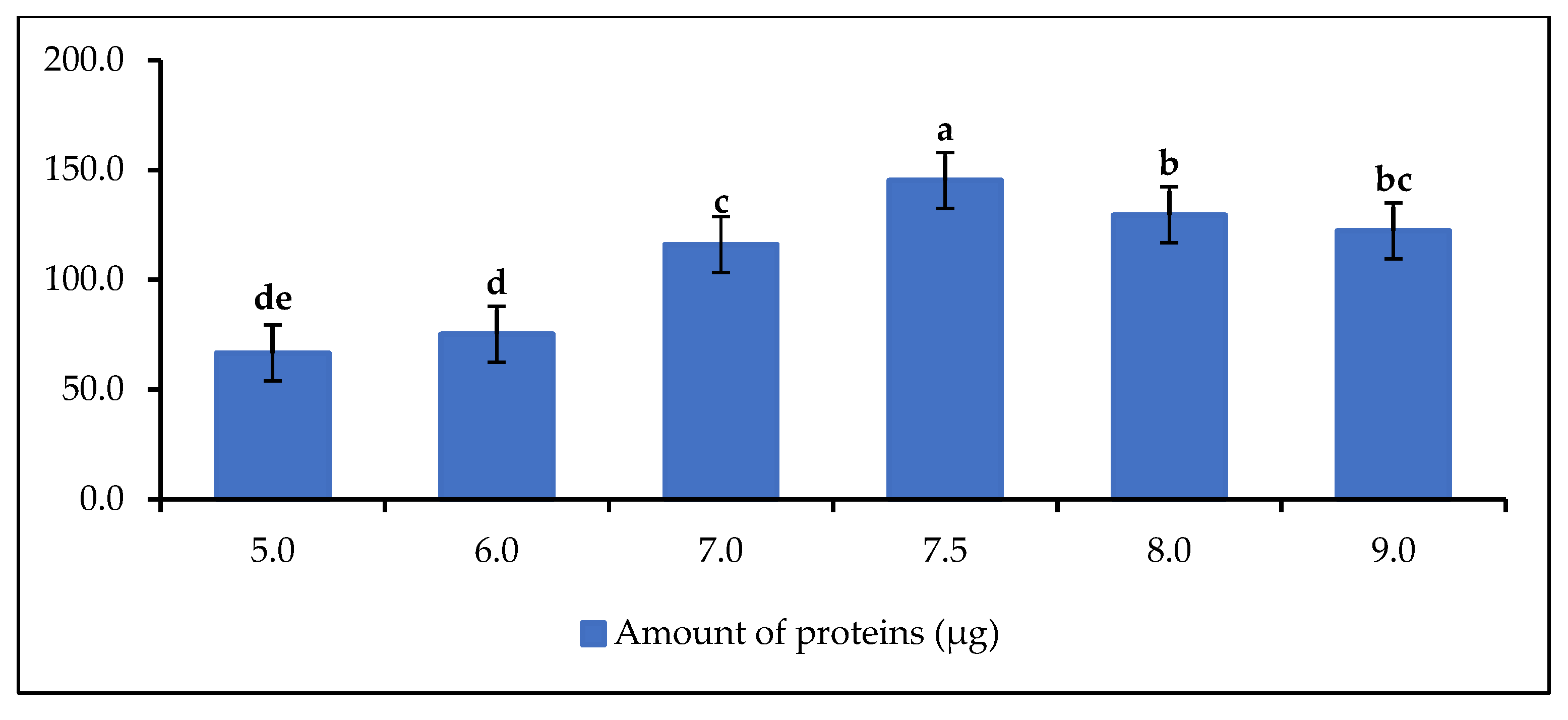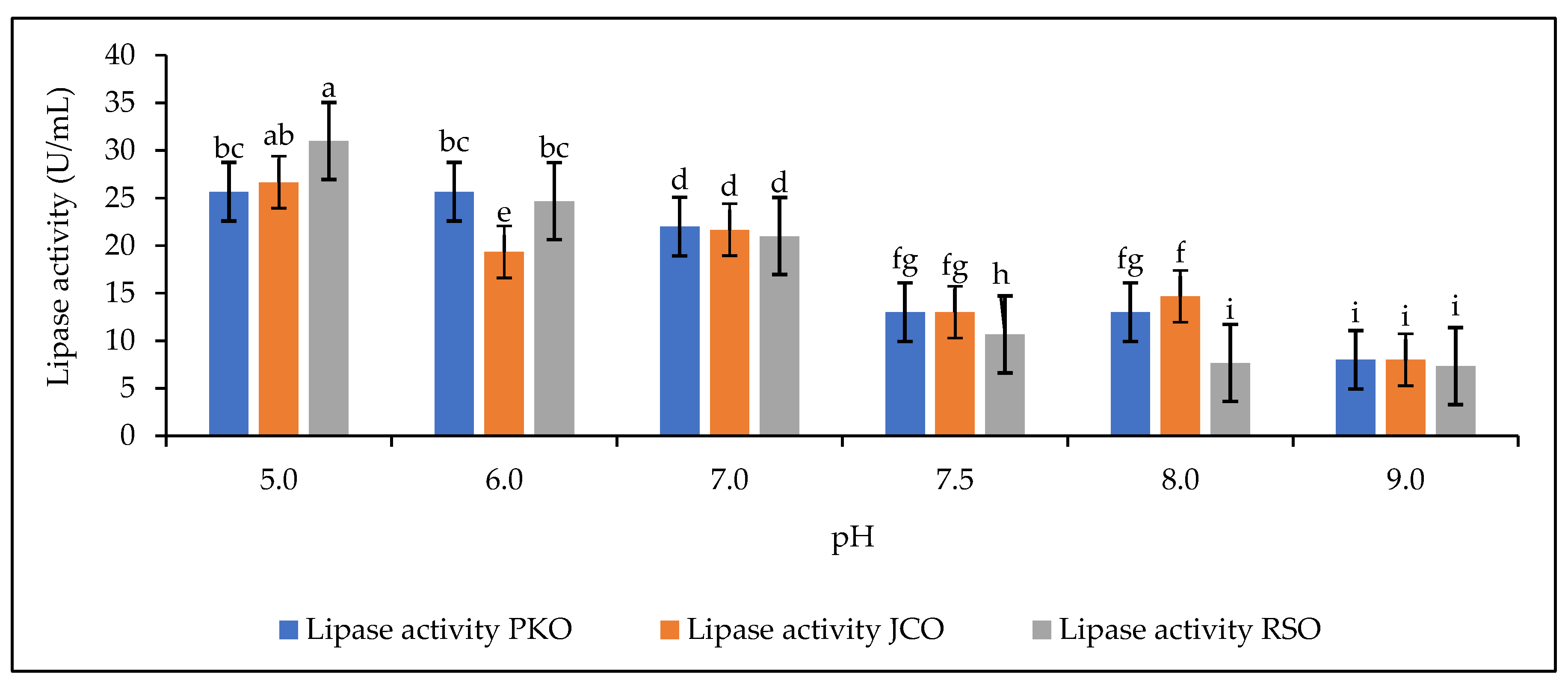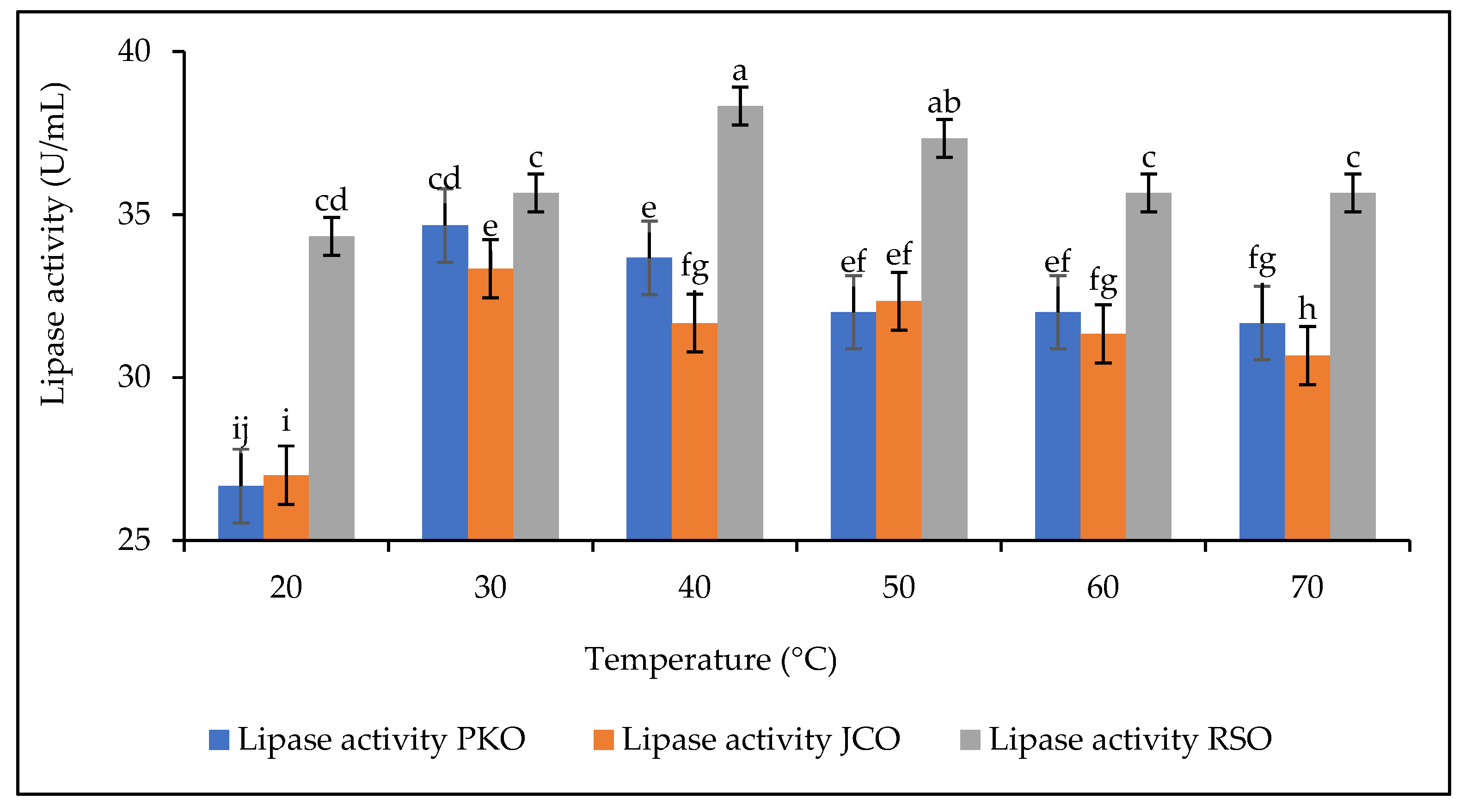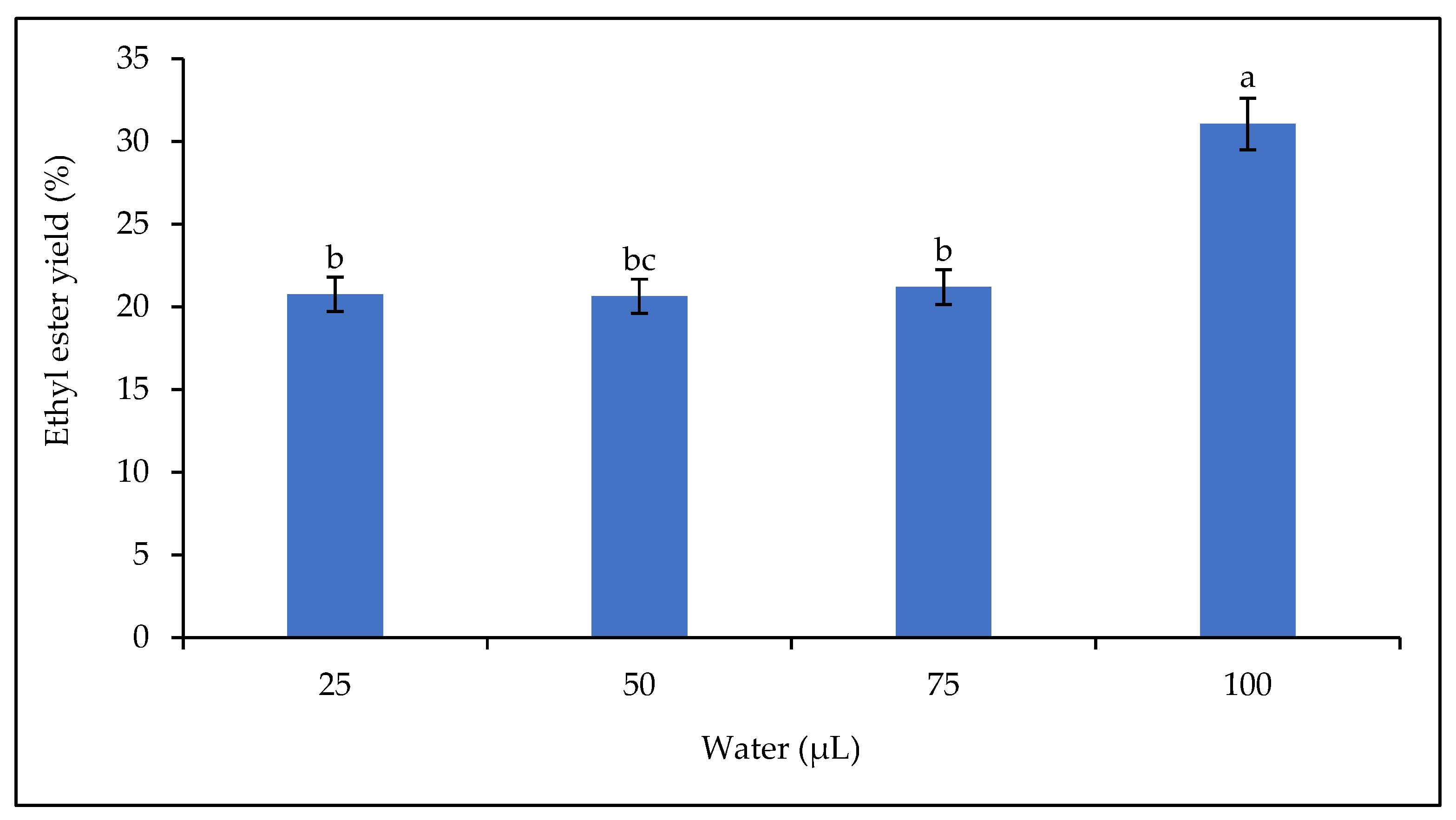Transesterification of Crude Rubber Oil Catalyzed by Lipase Extract Powder of Germinated Rubber Kernels for Biodiesel Production
Abstract
1. Introduction
2. Materials and Methods
2.1. Materials and Chemicals
2.2. Pre-Treatment and Characterization of Germinated Rubber Seeds
2.2.1. Moisture
2.2.2. Dry Matter
2.2.3. Ash
2.2.4. Fat
2.3. Extraction and Physicochemical Properties of Crude Oils
2.3.1. Acid Value
2.3.2. Kinematic Viscosity
2.3.3. Density
2.3.4. Calorific Value
2.4. Plant Lipase Extraction
2.4.1. Lipase Extract Powder Preparation
2.4.2. Lipase Solution Preparation
2.5. Protein Content in Lipase Solution
2.6. Evidence of Lipase by Hydrolysis Reaction
2.6.1. Effect of pH on Lipase Hydrolytic Activity
2.6.2. Effect of Extract Concentration on Lipase Hydrolytic Activity
2.6.3. Determination of Lipase Solution Thermal Stability
2.6.4. Determination of Lipase Storage Stability
2.7. Enzymatic Transesterification Reaction
2.7.1. Evaluation of Effect of Temperature on the Catalytic Activity of Lipase
2.7.2. Aqueous Transesterification Reaction
2.7.3. Co-Solvent Addition in Transesterification Reaction
2.8. FT-IR Analysis
2.9. SEM-EDX Analysis
2.10. Analysis of Ethyl Ester Formation by Gas Chromatography with Flame Ionization Detector
3. Results and Discussion
3.1. Characteristics of Germinated Rubber Kernels
3.2. Physicochemical Properties of Crude Oils Extracted
3.3. Lipase Extract Powder Characterization
3.4. Quantification of Protein in Solution
3.5. Lipase Hydrolytic Activity
3.5.1. Effect of Buffer pH on Lipase Hydrolytic Activity
3.5.2. Lipase Hydrolytic Activity According Extract Concentration
3.5.3. Effect of Temperature on Lipase Hydrolytic Activity
3.5.4. Effect of Storage Time on Lipase Hydrolytic Activity
3.6. Lipase Catalytic Activity on RSO
3.6.1. Composition of Interest Product Obtained After Transesterification Reaction
3.6.2. Effect of Temperature on Lipase Catalytic Activity
3.6.3. Effect of Water on Lipase Catalytic Activity
3.6.4. Effect of Co-Solvent Addition on Lipase Catalytic Activity
4. Conclusions
Author Contributions
Funding
Data Availability Statement
Acknowledgments
Conflicts of Interest
References
- Cheng, L.; Jiang, H.; Xie, G.; Wang, J.; Peng, W.; Zhou, L.; An, F. Photosynthesis and Latex Burst Characteristics in Different Varieties of Rubber Trees (Hevea Brasiliensis) under Chilling Stress, Combing Bark Tensile Property and Chemical Component Analysis. Forests 2024, 15, 1408. [Google Scholar] [CrossRef]
- Lestari, A.; Yerizam, M.; Hasan, A. Characterization of Rubber Seed (Hevea Brasiliensis) as Raw Material for The Production of Biofuel. J. Appl. Agric. Sci. Technol. 2023, 7, 217–224. [Google Scholar] [CrossRef]
- Koné, G.A.; Good, M.; Kouba, M. Performance of Guinea Fowl Fed Hevea Seed Meal or Cashew Nut Meal as a Partial Substitute for Soya Bean Meal. Animal 2020, 14, 206–214. [Google Scholar] [CrossRef] [PubMed]
- Widyarani; Coulen, S.C.W.; Sanders, J.P.M.; Bruins, M.E. Valorisation of Proteins from Rubber Tree. Waste Biomass Valorization 2017, 8, 1027–1041. [Google Scholar] [CrossRef]
- Tambunan, B.; Ambarita, H.; Sitorus, T.; Sebayang, A.; Masudie, A. An Overview of Physicochemical Properties and Engine Performance Using Rubber Seed Biodiesel–Plastic Pyrolysis Oil Blends in Diesel Engines. Automot. Exp. 2024, 6, 551–583. [Google Scholar] [CrossRef]
- Hussain, M.; Khan, I.; Jiang, B.; Zheng, L.; Pan, Y.; Hu, J.; Ashraf, A.; Salah, A.; Salahuddin, A.; Al-Ansi, W.; et al. Lipases: Sources, Immobilization Techniques, and Applications. Int. J. Environ. Agric. Biotechnol. 2023, 8, 094–121. [Google Scholar] [CrossRef]
- Godoy, C.A.; Pardo-Tamayo, J.S.; Barbosa, O. Microbial Lipases and Their Potential in the Production of Pharmaceutical Building Blocks. Int. J. Mol. Sci. 2022, 23, 9933. [Google Scholar] [CrossRef]
- Liu, X.; Kokare, C. Chapter 17–Microbial Enzymes of Use in Industry. In Biotechnology of Microbial Enzymes (Second Edition); Brahmachari, G., Ed.; Academic Press: New York, NY, USA, 2023; Volume 11, pp. 405–444. ISBN 978-0-443-19059-9. [Google Scholar]
- Okino-Delgado, C.H.; Pereira, M.S.; Prado, D.Z.D.; Fleuri, L.F. Evaluation of the Influence of Chemical and Physical Factors on Mixtures of Fungal and Plant Lipases. An. Acad. Bras. DeCiências 2022, 94, e20201268. [Google Scholar] [CrossRef]
- Gonawan, F.N.; Romli, M.M.; Zuhan, M.K.N.M.; Jaya, M.A.T. Immobilization of Candida Rugosa Lipase on the Glutaraldehyde-Activated Chitosan Beads. J. Chem. Eng. Ind. Biotechnol. 2022, 8, 33–41. [Google Scholar] [CrossRef]
- Ahmad, N.F.B.; Veny, H.; Che Mat, S.Z. Investigation on Enzymatic Activity of Rubber Seed as Source of Plant Lipase. Malays. J. Chem. Eng. Technol. 2020, 3, 45–50. [Google Scholar] [CrossRef]
- Al-Haidari, A.; Khudhair, S.; Alsaadawi, I. Extraction and Purification of Lipases Enzyme from Germinating Seeds of Four Crops. Iraqi J. Sci. 2020, 61, 2182–2188. [Google Scholar] [CrossRef]
- Kouteu, N.P. Mise En Œuvre Des Lipases Végétales Issues Des Graines Dans La Catalyse Enzymatique d’esters Éthyliques d’huiles Végétales Pour La Production de Biodiesel. Ph.D. Thesis, Université de Montpellier, SupAgro, Montpellier, France, 2017. [Google Scholar]
- Aghaei, H.; Ghavi, M.; Hashemkhani, G.; Keshavarz, M. Utilization of Two Modified Layered Doubled Hydroxides as Supports for Immobilization of Candida Rugosa Lipase. Int. J. Biol. Macromol. 2020, 162, 74–83. [Google Scholar] [CrossRef] [PubMed]
- Alloue, W.A.M.; Aguedo, M.; Destain, J.; Ghalfi, H.; Blecker, C.; Wathelet, J.-P.; Thonart, P. Les lipases immobilisées et leurs applications. Biotechnol. Agron. Soc. Env. 2008, 12, 57–68. [Google Scholar]
- Barros, M.; Fleuri, L.F.; Macedo, G.A. Seed Lipases: Sources, Applications and Properties–a Review. Braz. J. Chem. Eng. 2010, 27, 15–29. [Google Scholar] [CrossRef]
- Xie, W.; Huang, M. Fabrication of Immobilized Candida Rugosa Lipase on Magnetic Fe3O4-Poly(Glycidyl Methacrylate-Co-Methacrylic Acid) Composite as an Efficient and Recyclable Biocatalyst for Enzymatic Production of Biodiesel. Renew. Energy 2020, 158, 474–486. [Google Scholar] [CrossRef]
- Moussavou, M.R.W.; Brunschwig, C.; Baréa, B.; Villeneuve, P.; Blin, J. Assessing the Enzyme Activity of Different Plant Extracts of Biomasses from Sub-Saharan Africa for Ethyl Biodiesel Production. Energy Fuels 2016, 30, 2356–2364. [Google Scholar] [CrossRef]
- Nanssou, K.P.A.; Baréa, B.; Barouh, N.; Blin, J.; Villeneuve, P. Lipase Activity of Tropical Oilseed Plants for Ethyl Biodiesel Synthesis and Their Typo- and Regioselectivity. J. Agric. Food Chem. 2016, 64, 8838–8847. [Google Scholar] [CrossRef]
- Moussavou, M.R.W.; Brunschwig, C.; Baréa, B.; Villeneuve, P.; Blin, J. Are Plant Lipases a Promising Alternative to Catalyze Transesterification for Biodiesel Production? Prog. Energy Combust. Sci. 2013, 39, 441–456. [Google Scholar] [CrossRef]
- Seth, S.; Chakravorty, D.; Dubey, V.K.; Patra, S. An Insight into Plant Lipase Research–Challenges Encountered. Protein Expr. Purif. 2014, 95, 13–21. [Google Scholar] [CrossRef]
- Istyami, A.; Sari, M.; Gultom, C.; Prakoso, T.; Soerawidjaja, T. Exploration of Novel Lipase from Plant Seeds and Plant Latexes. Indones. J. Chem. Res. 2024, 12, 1–8. [Google Scholar] [CrossRef]
- Moussavou, M.R.W. Synthèse Enzymatique D’esters Ethyliques D’huiles Végétales pour la Production de Biodiesel à L’aide de Lipases Végétales Issues de la Biomasse Africaine. Ph.D. Thesis, Université de Montpellier, SupAgro, Montpellier, France, 2014. [Google Scholar]
- Association of Official Analytical Chemists (AOAC). Official Methods of Analysis of AOAC International, 18th ed.; AOAC: Baltimore, MD, USA, 2005. [Google Scholar]
- ASTM D1209; Test Method for Color of Clear Liquids (Platinum-Cobalt Scale). American Society for Testing and Materials ASTM International: West Conshohocken, PA, USA, 2017. [CrossRef]
- ISO 660; Animal and Vegetable Fats and Oils: Determination of Acid Value and Acidity. ISO: Geneva, Switzerland, 2020.
- ASTM D445; Standard Test Method for Kinematic Viscosity of Transparent and Opaque Liquids (Incl. Calculation of Dynamic Viscosity). American Society for Testing and Materials ASTM International: West Conshohocken, PA, USA, 2006.
- NF 6883; Animal and Vegetable Fats and Oils Determination of Conventional Mass per Volume (Litre Weight in Air). ISO: Geneva, Switzerland, 2017.
- Batel, W.; Graef, M.; Mejer, G.J.; Moller, R.; Schoedder, F.; Batel, W.; Graef, M.; Mejer, G.J.; Moller, R.; Schoedder, F. Vegetable Oils as Sources of Fuel and Energy. Grund. Landtech 1980, 30, 40–51. [Google Scholar]
- NF T60-201; Animal and Vegetable Fats and Oils: Determination of Moisture and Volatile Matter Content. ISO: Geneva, Switzerland, 2016.
- Okunwaye, T.; Obibuzor, J.U.; Okogbenin, E.A. Purification and Biochemical Properties of Lipase from Raphia Palm Fruit Mesocarp. Afr. J. Biochem. Res. 2015, 9, 73–80. [Google Scholar] [CrossRef]
- Bradford, M.M. A Rapid and Sensitive Method for the Quantitation of Microgram Quantities of Protein Utilizing the Principle of Protein-Dye Binding. Anal. Biochem. 1976, 72, 248–254. [Google Scholar] [CrossRef] [PubMed]
- Gadge, P.P.; Madhikar, S.D.; Yewle, J.N.; Jadhav, U.U.; Chougale, A.D.; Zambare, V.P.; Padul, M.V. Biochemical Studies of Lipase from Germinating Oil Seeds (Glycine Max). Am. J. Biochem. Biotechnol. 2011, 7, 141–145. [Google Scholar] [CrossRef]
- Mohammadi, N.S.; Khiabani, M.S.; Ghanbarzadeh, B.; Mokarram, R.R. Improvement of Lipase Biochemical Properties via a Two-Step Immobilization Method: Adsorption onto Silicon Dioxide Nanoparticles and Entrapment in a Polyvinyl Alcohol/Alginate Hydrogel. J. Biotechnol. 2020, 323, 189–202. [Google Scholar] [CrossRef]
- Paichid, N.; Yunu, T.; Klomklao, S.; Prasertsan, P.; Sangkharak, K. Enhanced Synthesis of Fatty-Acid Methyl Ester Using Oil from Palm Oil Mill Effluents and Immobilized Palm Lipase. J. Am. Oil Chem. Soc. 2018, 95, 1373–1384. [Google Scholar] [CrossRef]
- Shamsudin, M.I.; Tan, L.S.; Tsuji, T.; Kiew, P.L. Production and Characterization of Biodiesel from Canola Oil through Enzymatic Transesterification. J. Phys. Conf. Ser. 2022, 2259, 012023. [Google Scholar] [CrossRef]
- Khan, M.F.; Kundu, D.; Hazra, C.; Patra, S. A Strategic Approach of Enzyme Engineering by Attribute Ranking and Enzyme Immobilization on Zinc Oxide Nanoparticles to Attain Thermostability in Mesophilic Bacillus Subtilis Lipase for Detergent Formulation. Int. J. Biol. Macromol. 2019, 136, 66–82. [Google Scholar] [CrossRef]
- Ameri, A.; Forootanfar, H.; Behnam, B.; Shakibaie, M.; Ameri, A.; Daneshpajooh, M.; Najafi, A.; Amirheidari, B. Optimization of Immobilization of Pseudomonas Cepacia Lipase on Multiwalled Carbon Nanotubes Functionalized with Glycyrrhizin and Tween 80. 3 Biotech 2021, 11, 260. [Google Scholar] [CrossRef]
- Yang, M.; Zhu, W.; Cao, H. Biorefinery Methods for Extraction of Oil and Protein from Rubber Seed. Bioresour. Bioprocess. 2021, 8, 45. [Google Scholar] [CrossRef]
- Oluodo, L.A.; Huda, N.; Komilus, C.F. Potential Utilization of Rubber Seed Meal as Feed and Food. Int. J. Eng. 2018, 7, 64–71. [Google Scholar] [CrossRef]
- Sugebo, B.; Demrew, Z.; Feleke, S.; Molla, M. Evaluation and Characterization of Rubber Seed Oil for Biodiesel Production. In Biomass Conversion and Biorefinery; Springer: Berlin/Heidelberg, Germany, 2021; pp. 1–11. [Google Scholar] [CrossRef]
- Udo, M.D.; Ekpo, U.; Ahamefule, F.O. Effects of Processing on the Nutrient Composition of Rubber Seed Meal. J. Saudi Soc. Agric. Sci. 2018, 17, 297–301. [Google Scholar] [CrossRef]
- Sharma, B.B.; Saha, R.K.; Saha, H. Effets de l’alimentation Avec de La Farine de Graines de Caoutchouc Détoxifiée Sur Les Performances de Croissance et Les Indices Hématologiques Des Alevins de Labeo Rohita (Hamilton). Anim. Feed Sci. Technol. 2014, 193, 84–92. [Google Scholar] [CrossRef]
- Kouassi, K.E.; Abolle, A.A.; Yao, K.B.; Boa, D.; Adouby, K.; Drogui, P.; Tyagi, R.D. Optimization of Rubber Seed Oil Transesterification to Biodiesel Using Experimental Designs and Artificial Neural Networks. Green Sustain. Chem. 2017, 8, 39–61. [Google Scholar] [CrossRef]
- Brahma, S.; Nath, B.; Basumatary, B.; Das, B.; Saikia, P.; Patir, K.; Basumatary, S. Biodiesel Production from Mixed Oils: A Sustainable Approach towards Industrial Biofuel Production. Chem. Eng. J. Adv. 2022, 10, 100284. [Google Scholar] [CrossRef]
- Halim, A.H.A.; Zamberi, M.M.; Husin, M.H.M.; Haminudin, N.F.; Idral, F.; Ghani, S.A. Physicochemical Properties of Jatropha Curcas Oil as a Potential Feedstock for Biodiesel Production. Proc. Mech. Eng. Res. Day 2022, 283–284. [Google Scholar]
- Novidzro, K.M.; Wokpor, K.; Fagla, B.A.; Koudouvo, K.; Dotse, K.; Osseyi, E.; Koumaglo, K.H. Etude de quelques paramètres physicochimiques et analyse des éléments minéraux, des pigments chlorophylliens et caroténoïdes de l’huile de graines de Griffonia simplicifolia. Int. J. Biol. Chem. Sci. 2019, 13, 2360. [Google Scholar] [CrossRef]
- Domonhedo, H.; Cros, D.; Nodichao, L.; Billotte, N.; Ahanhanzo, C. Enjeux et amélioration de la réduction de l’acidité dans les fruits mûrs du palmier à huile, Elaeis guineensis Jacq. (synthèse bibliographique). Biotechnol. Agron. Société Environ. 2018, 22, 54–66. [Google Scholar] [CrossRef]
- Ducret, A.; Pina, M.; Montet, D.; Graille, J. Désacidification enzymatique des huiles hyperacides. Oléagineux 1989, 44, 603–607. [Google Scholar]
- Reksowardojo, I.; Bui, H.N.; Sok, R.; Kilgour, A.J.; Brodjonegoro, T.P.; Soerawidjaja, T.H. The Effect of Biodiesel Fuel Rubber (Hevea Brasiliensis) Seed Oil on a Direct Injection (DI) Diesel Engine. Asean Eng. J. 2011, 1, 65–81. [Google Scholar] [CrossRef]
- Jain, S.; Sharma, M.P. Stability of Biodiesel and Its Blends: A Review. Renew. Sustain. Energy Rev. 2010, 14, 667–678. [Google Scholar] [CrossRef]
- Kouassi, E.K.; Abolle, A.; Yao, B.; Boa, D. Essais de Transestérifications comparées par méthanolyse et éthanolyse de l’huile de palme: Mesure de la densité et de la viscosité en relation avec la structure moléculaire. Int. J. Innov. Appl. Stud. 2015, 12, 918–930. [Google Scholar]
- Paul, A.K.; Borugadda, V.B.; Reshad, A.S.; Bhalerao, M.S.; Tiwari, P.; Goud, V.V. Comparative Study of Physicochemical and Rheological Property of Waste Cooking Oil, Castor Oil, Rubber Seed Oil, Their Methyl Esters and Blends with Mineral Diesel Fuel. Mater. Sci. Energy Technol. 2021, 4, 148–155. [Google Scholar] [CrossRef]
- Mortazavi, S.; Aghaei, H. Make Proper Surfaces for Immobilization of Enzymes: Immobilization of Lipase and α-Amylase on Modified Na-Sepiolite. Int. J. Biol. Macromol. 2020, 164, 1–12. [Google Scholar] [CrossRef]
- Taghizadeh, T.; Ameri, A.; Talebian-Kiakalaieh, A.; Mojtabavi, S.; Ameri, A.; Forootanfar, H.; Tarighi, S.; Faramarzi, M.A. Lipase@zeolitic Imidazolate Framework ZIF-90: A Highly Stable and Recyclable Biocatalyst for the Synthesis of Fruity Banana Flavour. Int. J. Biol. Macromol. 2021, 166, 1301–1311. [Google Scholar] [CrossRef]
- Eze, O.F.; Chatzifragkou, A.; Charalampopoulos, D. Properties of Protein Isolates Extracted by Ultrasonication from Soybean Residue (Okara). Food Chem. 2022, 368, 130837. [Google Scholar] [CrossRef]
- Onoji, S.E.; Iyuke, S.E.; Igbafe, A.I.; Daramola, M.O. Hevea Brasiliensis (Rubber Seed) Oil: Modeling and Optimization of Extraction Process Parameters Using Response Surface Methodology and Artificial Neural Network Techniques. Biofuels 2019, 10, 677–691. [Google Scholar] [CrossRef]
- Takase, M.; Zhao, T.; Zhang, M.; Chen, Y.; Liu, H.; Yang, L.; Wu, X. An Expatiate Review of Neem, Jatropha, Rubber and Karanja as Multipurpose Non-Edible Biodiesel Resources and Comparison of Their Fuel, Engine and Emission Properties. Renew. Sustain. Energy Rev. 2015, 43, 495–520. [Google Scholar] [CrossRef]
- Hasan, N.; Yie, T.; Zain, N.; Suhaimi, M. Immobilization of Candida Rugosa Lipase in PVA-Alginate-Sulfate Beads for Waste Cooking Oil Treatment. J. Teknol. 2015, 74, 221–228. [Google Scholar] [CrossRef]
- Robinson, P.K. Enzymes: Principles and Biotechnological Applications. Essays Biochem. 2015, 59, 1–41. [Google Scholar] [CrossRef]
- Santos, K.C.; Cassimiro, D.M.J.; Avelar, M.H.M.; Hirata, D.B.; de Castro, H.F.; Fernández-Lafuente, R.; Mendes, A.A. Characterization of the Catalytic Properties of Lipases from Plant Seeds for the Production of Concentrated Fatty Acids from Different Vegetable Oils. Ind. Crops Prod. 2013, 49, 462–470. [Google Scholar] [CrossRef]
- Hoppe, A.; Theimer, R.R. Rapeseed Lipase—PH Dependent Specificity for Native Lipid Body Autolysis and Lipolysis of Artifical Oil Droplets. J. Plant Physiol. 1997, 151, 390–398. [Google Scholar] [CrossRef]
- Weerasooriya, M.K.B.; Kumarasinghe, A.A.N. Isolation of Alkaline Lipase from Rubber Seed—Partial Purification, Characterization and Its Potential Applications as a Detergent Additive. Indian J. Chem. Technol. 2012, 19, 244–249. [Google Scholar]
- Yao, L.W.; Ahmed Khan, F.S.; Mubarak, N.M.; Karri, R.R.; Khalid, M.; Walvekar, R.; Abdullah, E.C.; Mazari, S.A.; Ahmad, A.; Dehghani, M.H. Insight into Immobilization Efficiency of Lipase Enzyme as a Biocatalyst on the Graphene Oxide for Adsorption of Azo Dyes from Industrial Wastewater Effluent. J. Mol. Liq. 2022, 354, 118849. [Google Scholar] [CrossRef]
- Tizchang, S.; Khiabani, M.S.; Mokarram, R.R.; Hamishehkar, H.; Bahramifar, N.; Hoon, P.J.; Pyo, S.H. Bacterial Cellulose Nano Crystal as Hydrocolloid Matrix in Immobilized β-Galactosidase onto Silicon Dioxide Nanoparticles. LWT 2020, 123, 109091. [Google Scholar] [CrossRef]
- Ali, Z.; Tian, L.; Zhao, P.; Zhang, B.; Ali, N.; Khan, M.; Zhang, Q. Immobilization of Lipase on Mesoporous Silica Nanoparticles with Hierarchical Fibrous Pore. J. Mol. Catal. B Enzym. 2016, 134, 129–135. [Google Scholar] [CrossRef]
- Hosseini, S.M.; Kim, S.M.; Mahmoud, S.; Younesi, H.; Nader, B.; Ji, H.P.; Sang-Hyun, P. Lipase-immobilized chitosan-crosslinked magnetic nanoparticle as a biocatalyst for ring opening esterification of itaconic anhydride. Biochem. Eng. J. 2019, 143, 141–150. [Google Scholar] [CrossRef]
- Aarthy, M.; Saravanan, P.; Gowthaman, M.K.; Rose, C.; Kamini, N.R. Enzymatic Transesterification for Production of Biodiesel Using Yeast Lipases: An Overview. Chem. Eng. Res. Des. 2014, 92, 1591–1601. [Google Scholar] [CrossRef]
- Arumugam, A.; Thulasidharan, D.; Jegadeesan, G.B. Process Optimization of Biodiesel Production from Hevea Brasiliensis Oil Using Lipase Immobilized on Spherical Silica Aerogel. Renew. Energy 2018, 116, 755–761. [Google Scholar] [CrossRef]
- Badgujar, V.C.; Badgujar, K.C.; Yeole, P.M.; Bhanage, B.M. Enhanced Biocatalytic Activity of Immobilized Steapsin Lipase in Supercritical Carbon Dioxide for Production of Biodiesel Using Waste Cooking Oil. Bioprocess Biosyst. Eng. 2019, 42, 47–61. [Google Scholar] [CrossRef]
- Guo, J.; Sun, S.; Liu, J. Conversion Des Déchets d’huile de Palme de Friture En Biodiesel En Utilisant La Lipase A Libre de Candida Antarctica Comme Nouveau Catalyseur. Fuel 2020, 267, 117323. [Google Scholar] [CrossRef]
- Green, K.D.; Nakajima, M. Evaluation of Immobilized Modified Lipase: Aqueous Preparation and Reaction Studies in n-Hexane. J. Am. Oil Chem. Soc. 1998, 75, 1519–1526. [Google Scholar] [CrossRef]
- Palocci, C.; Soro, S.; Cernia, E.; Fiorillo, F.; Belsito, C.M.A.; Monacelli, B.; Delle Monache, G.; Pasqua, G. Isoenzymes Lipolytiques Du Latex d’Euphorbia. Plant Sci. 2003, 165, 577–582. [Google Scholar] [CrossRef]
- Binhayeeding, N.; Klomklao, S.; Prasertsan, P.; Sangkharak, K. Improvement of Biodiesel Production Using Waste Cooking Oil and Applying Single and Mixed Immobilised Lipases on Polyhydroxyalkanoate. Renew. Energy 2020, 162, 1819–1827. [Google Scholar] [CrossRef]
- Quayson, E.; Amoah, J.; Rachmadona, N.; Hama, S.; Yoshida, A.; Kondo, A.; Ogino, C. Biodiesel-Mediated Biodiesel Production: A Recombinant Fusarium Heterosporum Lipase-Catalyzed Transesterification of Crude Plant Oils. Fuel Process. Technol. 2020, 199, 106278. [Google Scholar] [CrossRef]
- Mujtaba, M.A.; Haeng, M.; Masjuki, H.H.; Kalam, M.A.; Farooq, M.; Manzoore, E.M.S.; Gul, M.; Afzal, A.; Waqar, A.; Asad, R.; et al. Effect of primary and secondary alcohols as oxygenated additives on the performance and emission characteristics of diesel engine. Energy Rep. 2021, 7, 1116–1124. [Google Scholar] [CrossRef]
- Baweja, S.; Trehan, A.; Kumar, R. Combustion, Performance, and Emission Analysis of a CI Engine Fueled with Mustard Oil Biodiesel Blended in Diesel Fuel. Fuel 2021, 292, 120346. [Google Scholar] [CrossRef]












| Moisture | Dry Matter | Ash | Proteins | Fat |
|---|---|---|---|---|
| 33.48 | 66.51 | 3.36 | 15.75 | 50.11 |
| Physicochemical | Unit | JCO | PKO | RSO |
|---|---|---|---|---|
| Color | - | Golden yellow | Light yellow | Brown |
| Acid value | mg KOH. g−1 | 18.70 | 25.05 | 41.51 |
| Viscosity at 40 °C | cSt | 34.67 | 29.49 | 31.93 |
| Density at 31 °C | - | 0.84 | 0.87 | 0.84 |
| Calorific value | MJ.kg−1 | 39.58 | 38.08 | 39.90 |
| Moisture | % | 0.00 | 0.00 | 0.00 |
Disclaimer/Publisher’s Note: The statements, opinions and data contained in all publications are solely those of the individual author(s) and contributor(s) and not of MDPI and/or the editor(s). MDPI and/or the editor(s) disclaim responsibility for any injury to people or property resulting from any ideas, methods, instructions or products referred to in the content. |
© 2024 by the authors. Licensee MDPI, Basel, Switzerland. This article is an open access article distributed under the terms and conditions of the Creative Commons Attribution (CC BY) license (https://creativecommons.org/licenses/by/4.0/).
Share and Cite
Akossi, M.J.C.; Kouassi, K.E.; Abollé, A.; Ouedraogo, W.K.I.; Yao, K.B. Transesterification of Crude Rubber Oil Catalyzed by Lipase Extract Powder of Germinated Rubber Kernels for Biodiesel Production. Energies 2025, 18, 1252. https://doi.org/10.3390/en18051252
Akossi MJC, Kouassi KE, Abollé A, Ouedraogo WKI, Yao KB. Transesterification of Crude Rubber Oil Catalyzed by Lipase Extract Powder of Germinated Rubber Kernels for Biodiesel Production. Energies. 2025; 18(5):1252. https://doi.org/10.3390/en18051252
Chicago/Turabian StyleAkossi, Moya Joëlle Carole, Konan Edmond Kouassi, Abollé Abollé, Wennd Kouni Igor Ouedraogo, and Kouassi Benjamin Yao. 2025. "Transesterification of Crude Rubber Oil Catalyzed by Lipase Extract Powder of Germinated Rubber Kernels for Biodiesel Production" Energies 18, no. 5: 1252. https://doi.org/10.3390/en18051252
APA StyleAkossi, M. J. C., Kouassi, K. E., Abollé, A., Ouedraogo, W. K. I., & Yao, K. B. (2025). Transesterification of Crude Rubber Oil Catalyzed by Lipase Extract Powder of Germinated Rubber Kernels for Biodiesel Production. Energies, 18(5), 1252. https://doi.org/10.3390/en18051252






